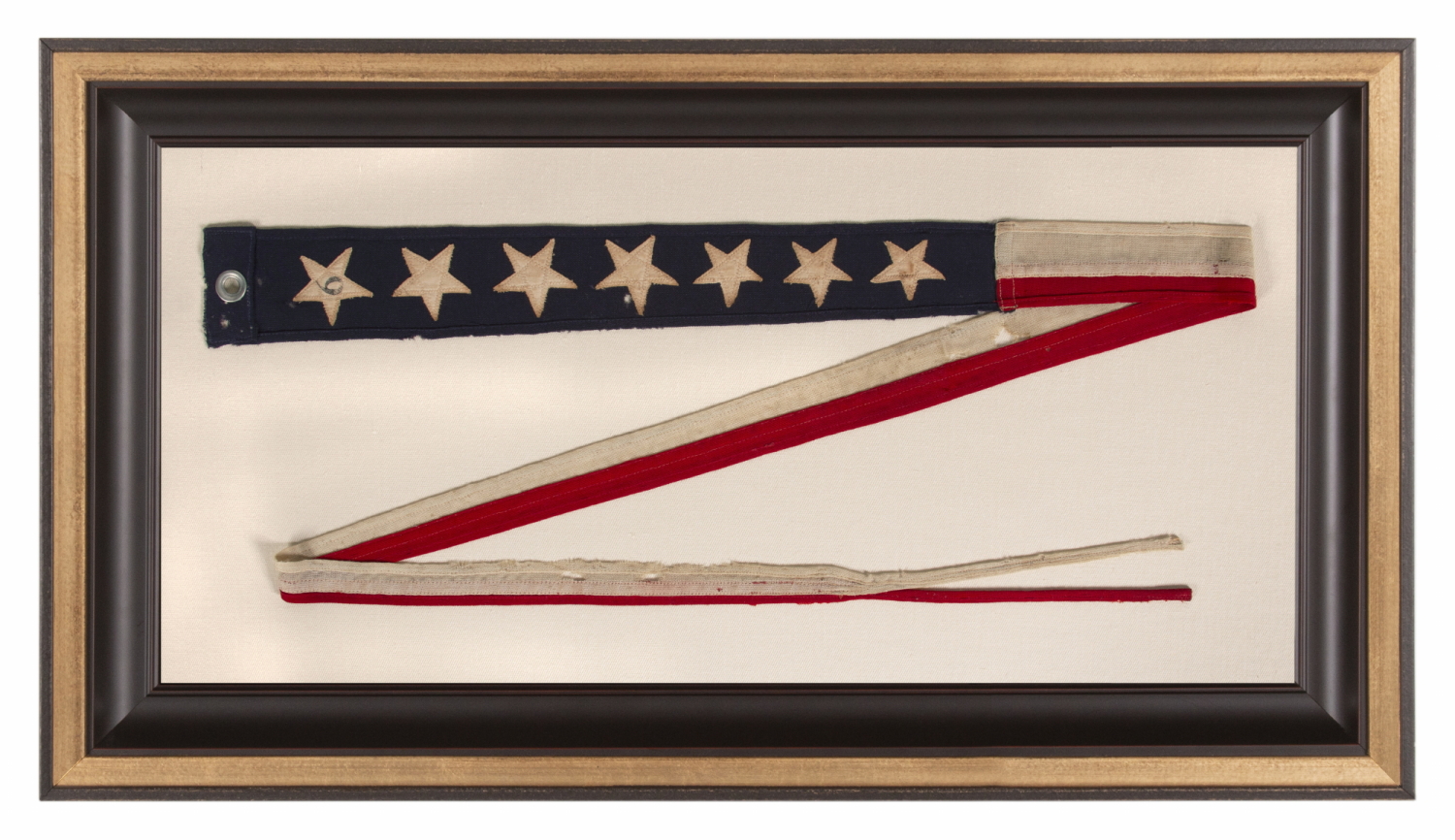
| |
“NO. 6” U.S. NAVY COMMISSION PENNANT WITH 7 STARS, MADE SOMETIME DURING THE WWI - WWII ERA (1917-1945) |
|
| Available: |
Sold |
| Frame Size (H x L): |
Approx. 18.25' x 35" |
| Flag Size (H x L): |
3" x 73.5" (unfurled) |
|
| Description....: |
|
7 star, U.S. Navy, ship's commission pennant, made sometime between roughly WWI (U.S. involvement 1917-18) and WWII (U.S. involvement 1941-45). Commission pennants are the distinguishing mark of a commissioned U.S. Navy ship. Flown at the masthead, the typical American format is a long blue field, usually with a single row of white stars, although sometimes with their total divided into two rows, followed by two long stripes, red-over-white. A ship became commissioned when this pennant was hoisted. Flown during both times of peace and war, the only time the pennant is not flown is if a flag officer or civilian official is aboard and replaces it with their own flag.
During the 18th and 19th centuries, these signals were a very important means of identifying the disposition of a ship. As a rule, they were very long. Though regulations of the latter 19th century specified the longest at 70 feet, some reached as 100 feet or more. This was the first thing one would see coming over the horizon and identified it as a warship.
Though in use from the 18th century onward, commission pennants first appear in the U.S. Navy regulations of 1864. Termed “narrow pennants,” eight different sizes were specified in that year, but count of stars remained unspecified until 1912.
Early on, commission pennants typically displayed a number of stars equal to that of the national flag. As more and more states joined the Union, it became impractical to use the full complement of stars, especially on smaller examples. During the mid-late 19th century, many substituted 13 stars for the full count, to reflect the original colonies. This mirrored the star count used by the Navy on most of its national flags flown on small craft. Prior to 1916, U.S. Navy “small boat ensigns," as they are called, typically displayed 13 stars.
Star counts for “Narrow Pennants” remained unspecified during the 19th century. They first appear in 1912, with the 7 star count specified for 4, 6, and 9-footers, and the 13 star count specified for all larger examples. It is of interest to note that, according to the U.S. Navy, the reason for the choice of 7 stars was not recorded. I once suspected this the number might logically reference the "7 Seas", before I discovered that this is a mythicized, ancient term, and geographers disagree on the precise meaning. The number may just as likely have represented what seemed like a logical design choice, when the overall length was substantially shortened.
For some reason, many 20th century examples display two different sizes of stars, usually with 4 larger, followed by 3 smaller, as-is the case with this example. This may have been a matter of practicality, because the severity of the taper was so much greater on a 4-6 foot pennant, versus, say, a 20 or 40-foot example.
The body of the pennant is made of wool bunting. The stars are made of plain weave cotton and are double-appliquéd (applied to both sides) with a zigzag, machine stitch. One of the stars bears a numeral “6,” applied with a black-inked stencil, which specified the numeric designation in 1912 U.S. Navy regulations, as well as the overall length in feet. The blue wool was rolled over, lined with cotton, and hemmed along the hoist, to which a single, to which a single, white metal grommet was added.
Mounting: The pennant was folded back-and-forth in an interesting zigzag fashion. It was mounted and framed within our own conservation department, which is led by expert staff. We take great care in the mounting and presentation of flags and have preserved thousands of examples.
The background fabric is 100% cotton twill, black in color. The cove shaped molding has a wood grained surface and is very dark brown in color, almost black. To this a black-painted, hand-gilded, and distressed Italian molding was added as a cap. Spacers keep the textile away from the glazing, which is U.V. protective glass. Feel free to contact us for more details.
Condition: There is minor to modest mothing throughout, accompanied by minor to modest foxing and staining in the stars. Many of my clients prefer early flags to show their age and history of use. |
|
|
|
| Collector Level: |
Beginners and Holiday Gift Giving |
|
| Flag Type: |
Sewn flag |
|
| Star Count: |
07 |
|
| Earliest Date of Origin: |
1917 |
|
| Latest Date of Origin: |
1945 |
|
| State/Affiliation: |
|
|
| War Association: |
WW 2 |
|
| Price: |
SOLD |
|
| |
Views: 172 |
|
|
|

